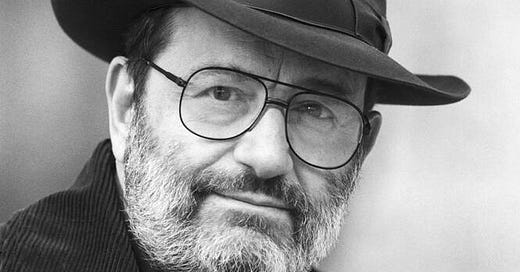Dear Anthony,
While we enjoy holidays and travel these last weeks of summer, I want to recommend an illustrated book that has given me immense pleasure, and I am sure will continue to do so, one that I was drawn to because of Miss MacIntosh, My Darling and my fascination with the literary aesthetics of abundance: Umberto Eco’s The Infinity of Lists: From Homer to Joyce, translated from the Italian by Alastair McEwan.
As we’ve discovered in traversing the first one hundred pages or so of Miss MacIntosh, Marguerite Young’s writing abounds with descriptive details, several of which we’ve cited in our previous posts: the pregnant girl on the bus; the sea-blackened house; frozen Indiana, to name just a few. Eco’s book offers up wonderfully entertaining lists, enumerations and catalogues in literature and visual art from Homer’s catalogue of ships in the Iliad to Calvino’s typology of books not read in Chapter 1 of If on a winter’s night a traveler.
Eco’s treatise is the product of an exhibit that he curated for the Louvre in 2009 and so joyfully celebrates abundance in art that one can only marvel at the many wonderful examples within. His selected literary excerpts and artworks are organized both chronologically and in loosely defined chapters, such as, “The visual list;” “The rhetoric of enumeration;” and “Coherent excess.” The colored plates of paintings, illustrations, statuary, and precious objects are stunning and inspiring.
My only complaint—why the dearth of examples from women writers and artists? Specifically, why, oh why, did no one hand Mr. Eco a copy of Miss MacIntosh, My Darling as he was curating this grand project?!
With a head swimming in masculine abundance,
Lori





Thank you, Lori, for your piece on lists in Young’s novel. I’ve been finding them everywhere. I had been seeing them in the context of copia, the rhetorical technique of amplification and abundance. Besides her lists, I’ve noted her tendency to suspend a sentence while pursuing a rich detour that may itself have modifications and sub-clauses before it lands again several lines down. You practically need to diagram the sentences if you are not to get lost.
I’m interested now in how this copious style relates to our pace of reading. On the one hand, the pace is fast: a torrential outpouring of lists, metaphors, digressions etc. But the pace is also slow, given that anything like a plot moves at a glacial rate. I’ve just finished four chapters in a row devoted to the lady’s opium visions. What is said of her there is that she never leaves her bed, never goes anywhere; and at the same time, she is everywhere, at the farthest reaches of the globe and beyond. Reading this novel puts us in the same paradoxical situation. My compromise is to read the work as if I were reading it aloud, though I don’t actually do so. This allows me to appreciate the rhythms and cadences of Young’s prose, which itself has an opiate effect.
Peter